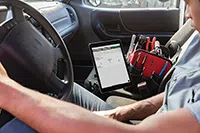Scheduling is always a challenge, no matter what industry, but it’s particularly difficult for HVACR business owners.
Unique Scheduling Challenges for HVACR Businesses
Often, when appointments are set there isn’t a lot of detail from the customer. A common call is simply we don’t have air-conditioning, or we don’t have heat. Details are vague because customers just don’t know how to explain the problem. When you combine that set of challenges with the fact that HVACR systems are often extraordinarily complex, it can be difficult for a business to accurately predict how long they are going to be spending on-site. This is different than other industries like landscaping, pool cleaning, or painting – all of which are more predictable.
Scheduling then, is a vital part of management to keep service and installations on time and to maintain happier customers. Fleet management technology is one way to solve scheduling management issues. It is a viable solution and one that facilitates easy communication between the field and the office in real time. This can start small, in the form of a device installed in the truck, and it can grow to include a robust mobile application upgrade. In any event, it's important that businesses have access to a real-time vehicle location and that this information is integrated into their job scheduling system. It’s a technology that allows management to see the full scope of service and make accurate scheduling decisions about where and when to send technicians.
Fleet Management Technology – It’s More Than Simple GPS
When it comes to real-time visibility of vehicles, a best practice is a fleet management technology solution designed to give a business a 360-degree view of company equipment and vehicles. Primarily, it starts with the reliance on GPS technology. It comes down to a small device installed within the vehicle that not only tracks certain information about the vehicle, but also the driver. For your service vans and trucks, this technology can track speed, engine hours, whether engines are on or off, at idle or in driving mode, as well as the vehicles’ location. Fleet technology is not only good for tracking and scheduling your fleet, but also about making a commitment to saving the business money. Combining vehicle data into an integrated system, allows you to save fuel and maintenance costs, and offers opportunities to start analyzing trends that will create best practices. For example, you can analyze driving profiles and behavior trends to ensure that they align with preferred safety metrics.
A Profile of Fleet Drivers by Name and by Behavior
The real-time data of fleet technology allows business owners to make real-time data decisions, but also to track trends over time. Fleet technology offers the capability to run a report daily or weekly and then compare these trends over time. You can run a report against a specific set of vehicles or do a deep dive into one vehicle or even one driver, to understand what is happening. If there are problems, this data allows you to mitigate issues immediately before larger problems arise. Data analytics can include items like speed, fast acceleration, harsh cornering, and hard braking. All this information can be insightful for team meetings and training. Armed with knowledge, management can coach best practices and decide exactly what works as well as explain what is expected. Fleet Management – Technology Offers Real-Time Solutions There are a handful of business problems that a fleet management technology solution works to address. Here are outstanding HVACR concerns and the solutions a good fleet management technology offers:
1. How to Increase Productivity
Real time coordination of vehicles, equipment and people combined with daily schedules, allows service managers to better manage how resources are utilized. This is a first step to help HVACR contractors be more productive.
2. Safety Issues
Consider how this technology can affect the safety of your team. Safety is essential for the drivers. For obvious reasons, we want our drivers to stay safe. Add to that, the idea of vehicle costs, maintenance, insurance, and fuel, and it all impacts the bottom line of the company.
3. Reputation
Your fleet carries your name, logo, phone number, and more. Part of your company’s reputation is based on how your vehicles travel throughout the community. And they are being monitored daily by other drivers on the roadway. If a driver is not driving appropriately, it reflects poorly on your business. This can lead to a bad reputation and to a loss of business. In communities large and small, word-of-mouth referrals are extremely important. Inconsiderate driving can be quite damaging.
4. Legal Exposure
Crashes are not only expensive to repair but can leave a business exposed legally. A large, injury-based lawsuit involving an employee or another driver or both, can cripple a company financially.
5. Customer Retention
Unsafe driving, poorly maintained vehicles, and late appointment arrivals all impact customer satisfaction. They also impact customer reviews and repeat business.
6. Maintenance & Repair Costs
Finally, most companies that don’t have fleet management technology, are missing the benefits of maintenance tracking technology on their vehicles. Fleet management effectively tracks all aspects of maintenance. Everything from simple oil changes and tire rotation to emission testing and battery maintenance. The right technology can ensure your fleet stays on the road. Fleet management software helps maintain the fleet with monthly or weekly reporting technology.
Investing in Fleet Technology vs. The Status Quo
One of the common pushbacks from owners is the cost of fleet management software. But as mentioned earlier, it’s easy to start small and add options as necessary. Often owners find their technicians are more efficiently routed which saves time and fuel. The time savings allows for additional service calls. Imagine five service techs making one additional call per day. Multiplied by the week and then the month, and it’s easy to see how these systems pay for themselves and then some.
What is the Next Step?
Fleet management software is quite simple and easy to install. If you start small, you can simply self-install a system. Typically, it is as easy as plugging a unit into the OBD2 port – a little area underneath your steering wheel that allows you to connect to the vehicle on board computer. If you are a small business on a budget, start there, with simple technology that allows GPS monitoring. Then as your company grows, you can decide to upgrade the technology with more robust options like dash cams or even utilizing engine data to learn more about whether seat belts are being used or windshield wipers are being activated. The fleet management technology can be as big or small as you decide.
Kevin Aries leads Global Product Success for Verizon Connect, helping build software solutions that optimize the way people, vehicles and things move through the world. Working predominantly with field service businesses, Kevin spends his time understanding the problems and solutions of the service industry to improve customer experience. For additional information, visit verizonconnect.com.



